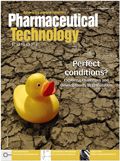Direct Compression Versus Granulation
Pharmaceutical Technology Europe
Compressed tablets are the most widely used solid dosage form so they must satisfy a number of physical requirements in terms of hardness, disintegration ability, friability and uniformity.
Compressed tablets are the most widely used solid dosage form so they must satisfy a number of physical requirements in terms of hardness, disintegration ability, friability and uniformity. To provide these tablet characteristics in accordance with the chosen ingredients, manufacturers can use three different processing technologies: direct compression, dry granulation and wet granulation.
Direct compression
Direct compression is a popular choice because it provides the shortest, most effective and least complex way to produce tablets. The manufacturer can blend an API with the excipient and the lubricant, followed by compression, which makes the product easy to process. No additional processing steps are required.
Moisture or heatsensitive ingredients, which would be contraindicated in wet granulation, can also be used in this type of process. However, it does require a very critical selection of excipients in comparison to granulation processes because the raw materials must demonstrate good flowability and compressibility for successful operation.
Both high and low doses of API present a challenge in this respect. Most APIs tend to have poor compressibility, which affects the quality of tablets if the formulation calls for a large proportion of API. At the same time, there can also be problems when low amounts of actives need to be incorporated into tablets because it is difficult to accurately blend a small amount of active in a large amount of excipient to achieve the desired uniformity and homogeneity.
For instance, segregation of the different components can occur. This means there is not a uniform distribution of tablet ingredients being fed to the press, and thus batchtobatch consistency of the manufactured tablet cannot be assured.
One of the principal risk factors for segregation is the wide particle size distribution in direct compression formulations, in which active ingredients tend to be at the fine end of the range. Where there is a wide range of particle sizes, there is an increased likelihood of sifting, where the smaller particles 'slip through' the bigger ones.
Other bulk powder properties are also important for successful tabletting, such as good flowability, and all of these factors combine to place a high requirement on the excipients used for direct compression.
Granulation
If a powder blend's properties do not suit direct compression tabletting, manufacturers will turn to granulation processes to create the desired flowability and low dustability. These characteristics are required to minimise tablet weight variations, and ensure high density for high tablet filling weight and high moldability for hard tablet manufacture.
Granulation narrows the particle size distribution of a tablet formulation's bulk powder, eliminating segregation problems. This in turn ensures superior compressibility in the tabletting process, permitting higher quantities of API to be used and ensuring good active distribution in the tablet. However, granulation is a more time-consuming technique compared with direct compression and there is also a risk of product cross-contamination and product loss during the different processing steps (granulation, drying, sieving). All of these factors can increase costs compared with direct compression.
Dry granulation is more flexible than direct compression. Compared with wet granulation, however, it has a shorter, more cost-effective manufacturing process. Because it does not entail heat or moisture, dry granulation is especially suitable for active ingredients that are sensitive to solvents, or labile to moisture and elevated temperatures.
Challenges for excipient manufacturers
As many of us know all too well, the pharma industry is in a state of flux with blockbuster API molecules coming off patent, Big Pharma companies reinventing their business models and generics becoming increasingly prevalent. Pharma manufacturers are extremely focused on cost effectiveness, but are also looking for a much higher level of innovation from excipient providers, recognising that excipients need to be considered alongside the API for a tablet formulation's overall success.
Often, the challenge for excipient producers is not the creation of new excipients per se, but new and innovative ways of using existing excipients to deliver new functionality or to be more cost-effective. For example, we have developed a way of using glucose monohydrate as a sole excipient (diluent binder) in dry granulation, employing a roller compaction technique to create strong chewable tablets, which would otherwise have required an additional binder such as maltodextrin. In wet granulation, the biggest role is played by the binder because its properties affect granule quality. Wet granulation tabletting methods have been developed that result in good end products. For example the combination of erythritol and isomalt, two polyols with low hygroscopic profiles, results in better stability of the end product.
Tablet manufacturers are realising that APIs do not have sole responsibility for innovation in their products. Indeed, the creative use of excipients can add significant value to the end formulation; by making it easier to consume a specific dosage form, certain excipients can provide fresh marketing angles for wellestablished APIs in over-the-counter (OTC) formulations, or improve patient compliance in prescribed formulations.
Liesbeth Meeus is Application Centre Leader for Cargill Pharma & Personal Care EMEA.
This article is part of a special feature on granulation that was published in the March issue of PTE Digital, available at www.pharmtech.com/ptedigital0311

Pharmaceutical Tariffs Are Imminent: How Industry is Bracing for Impact
April 16th 2025On April 14, 2025, the Trump Administration launched a national security-driven investigation into pharmaceuticals, a move that will likely result in tariffs being placed on pharmaceutical drugs, ingredients, and other components that are imported from outside of the United States.
Drug Solutions Podcast: A Closer Look at mRNA in Oncology and Vaccines
April 30th 2024In this episode fo the Drug Solutions Podcast, etherna’s vice-president of Technology and Innovation, Stefaan De Koker, discusses the merits and challenges of using mRNA as the foundation for therapeutics in oncology as well as for vaccines.